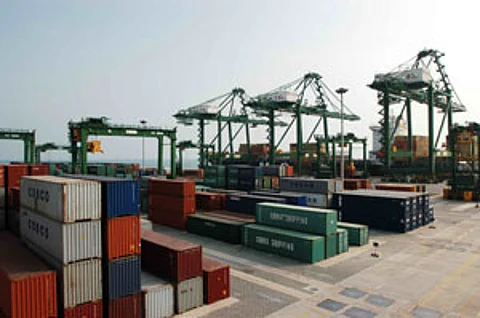

Qingdao Port, the seventh-largest port in the world, is gearing up to make itself the international freight center of northeast Asia by constructing a series of new docks and developing a newly approved bonded area.
"We are actually building another Qingdao Port," said Tian Guangwen, Vice President of Qingdao Port (Group), referring to the new construction project in Dongjiakou, south of the port's 117-year-old base in Kiaochow Bay.
In 2008, business at the port increased by 13 percent despite a gloomy economy. From January to July this year, traffic and revenues at Qingdao Port enjoyed a five percent year-on-year growth.
The port has gross capital of US$3.18 billion, with a debt ratio of 20 percent. Port representatives said that the company would clear its debts within twelve months.
Mr Tian said the first project being built at Dongjiakou is an iron ore dock requiring a US$440 million investment. Its partner will be Brazilian mining giant Vale, the largest iron ore producer in the world. Vale, which lists China as its main market, produces 300 million tonnes of iron ore per annum.
Mr Tian said that because of the economic slowdown, Vale is looking for ways to reduce costs.
"The transportation distance for Brazil's iron ore is very long, so huge ships are needed to cut the cost efficiently," Mr Tian said.
Serving larger ships
Vale is planning to complete 16 ships, each with a capacity of 400,000DWT, and reportedly will launch the first ship in 2010. Each ship will save 30 percent in costs.
"How huge a ship can be depends on how huge a dock we have," said Wang Baosheng, Vice Head of the group business department for the Qingdao Port.
Mr Wang said the new dock at Dongjiakou would be the first in China to accommodate the ships large enough to carry 400,000 tonnes of minerals.
The port will build four docks for ships with a 400,000DWT capacity, two for ships with a 200,000DWT capacity and five docks for ships with a 100,000DWT capacity.
According to the construction plan, 112 berths will be constructed at Dongjiakou, 21 more than at the existing port.
Mr Tian said the capacity of the new docks would be about 40 million tonnes in three to five years, exceeding the traffic of the existing Qingdao Port.
"Operations of all projects at Dongjiakou will begin in eight years. Once finished, Qingdao Port is expected to surpass Pusan Port in South Korea, and we will realise our goal of becoming the international freight center of northeast Asia," Wang said.
Mr Tian declined to reveal the total investment for the entire port expansion project.
Dongjiakou is surrounded by seawater on three sides and a coastline of more than 29km. The natural depth near shore averages 15 metres, and the depth increases to 20 metres at a distance of 1,000 metres from the shore.
Connections with international freight lines, highways and railroads are added advantages at Dongjiakou.
Being a natural deepwater port, free of silt and freezing, the port has established trade relations with more than 450 ports in more than 130 countries and regions.
Bonded port
As part of its expansion project, Qingdao Port also is developing a bonded port area to attract more domestic and international resources.
On September 1, the Qianwan Bonded Port Area was approved as the seventh of its kind in China. The 9.8 square metre first phase consists of eight container berths, two multifunctional berths, and dock operations for comprehensive logistics, international logistics and export machining.
The area will provide bonded service for foreign and domestic cargo.
"The area will boost development of Qingdao Port in the future. And companies will enjoy convenient customs formalities, favorable tax policies, less trade restrictions and so on," Mr Wang said.
Ren Minqiang, Head of Qingdao Qianwan Container Terminal, (QQCT), said the bonded area is a chance for the port to become an international container transfer facility.
"We should take advantage of the policies and increase container quantity first, then attract cargos from Pusan Port with our great service," Mr Ren said.
In 2005, Pusan Port invested US$8 billion to expand and maintain its leading role in Northeast Asia.
Other Chinese ports including Shanghai's Yangshan Port, Dalian Port and Tianjin Port are also eying expansion plans.
Tracey Jia
